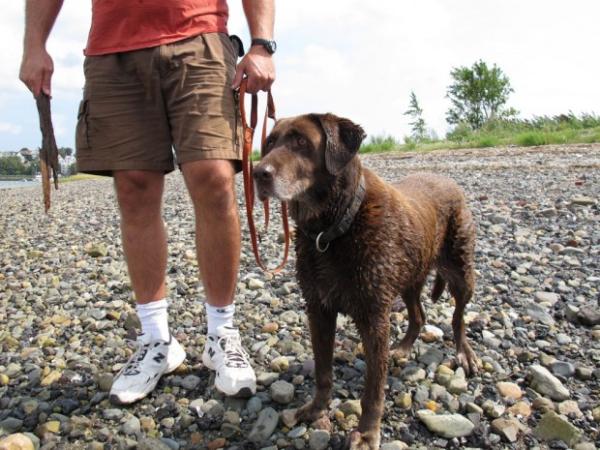9/11 Rescue Dogs Serve As Tools, Companions

Four Federal Emergency Management Agency (FEMA) dogs based out of Beverly were among the first to arrive at the World Trade Center hours after the Sept. 11 attacks.
Moxie was 3 years old at the time, freshly certified as an Urban Search and Rescue dog. It was the first assignment for the chocolate Lab and her owner, Mark Aliberti, who was a Winthrop firefighter at the time.
“The World Trade Center — for lack of a better term — it was a complete mess,” Aliberti said. “The terrain we were working on was pretty unusual. A lot of steel, a lot of just — everything was there.”
During the eight days at ground zero, Aliberti and Moxie started searching for survivors in one of the World Trade Center buildings that was still standing.
Finding live victims is really important to a dog like Moxie. To keep her spirits up, to keep her focused, her owner, Mark Aliberti, took the time to find ways to reward her.
Moxie was about 50 feet ahead, leading the way. All of a sudden, the smoke started thickening. Aliberti and his team leader agreed: it was time to get out.
“And all of a sudden the dog goes by me. I think she could hear the tones in our voice that things changed — ‘I’m leaving,’ ” he said. “She knew it was a hazardous situation, she was doing what she was told, but as soon as we were ready to go, she didn’t have to be told to leave.”
As a team, Aliberti would help navigate Moxie through the twisted steel and concrete rubble, and let her nose do the work. Section by section, they searched for survivors.
After not finding anything, Moxie would often re-search the area and find cadavers, even though she was trained to ignore them.
“She’d turn around to check where I was because she’d know she wasn’t supposed to be messing around over there,” he recalled.
“So I’d go over and I started marking these spots after a couple of days. And I’d mark them, and we’d leave, because we were still hoping to find live victims. And what happened is that eventually I think it became apparent to everybody that three or four days into it that we probably weren’t going to find anymore live victims.”
Finding those live victims is really important to a dog like Moxie. To keep her spirits up, to keep her focused, Aliberti took the time to find ways to reward her.
He would often ask other firefighters to hide among the rubble, so Moxie could find somebody.
“That’ll bolster them, get them up and running again,” Aliberti explained. “You have to do that after a while because it’s long days.”
But after four days and in spite of those games, Aliberti and Moxie couldn’t escape the dangers. Once when they were playing tug-of-war at the site, he didn’t realize that big chunks of glass were hidden underneath layers of thick, thick dust.
“I realized it was blood,” he said, remembering seeing her hind paw torn up. “She cut a pretty good flap out of it.”
They went to the team veterinarian, who said Moxie would not be able to continue working while her paw healed. So Aliberti headed back to the Javitz Center, which served as a staging area for the FEMA teams. There, he ran into veterinarian Lori Gordon, who recommended gluing the flap of Moxie’s paw back together.
“We’d treat it, superglue it, and wrap it for the night. And then the next day, I’d usually take the wrapping off and we’d just go with the superglue. And she’d usually be able to get through the day as long as it didn’t get too wet,” Aliberti explained. “It’s more of a military mentality … you treat the people you can put back in the fight as soon as possible.”
Ten years later, that fight is over now for Moxie.
At 13 and with some gray hairs on her muzzle, she and Aliberti still spend a lot of time together. They often go to Coughlin Park in Winthrop to enjoy a sunny day outside.
Оставить комментарий
Для комментирования необходимо войти через ![]() Вконтакте
Вконтакте
